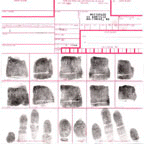| Author | Message | ||
Webservant (member) Moderator Username: member Post Number: 202 Registered: 03-1997 |
The question you pose is important because fingerprint recording sequence errors are one of the most common problems encountered in fingerprint repositories. To help preclude such errors, national and international fingerprint standards specify that records include ten rolled impressions of the individual fingers and thumbs, two plain impressions of the thumbs, and two simultaneously obtained plain impressions of the four remaining fingers on each hand. On ink and paper fingerprint cards, these impressions are represented by (from left to right) the four left hand fingers recorded simultaneously, then the left thumb, then the right thumb, then the right hand fingers recorded simultaneously.  Live scan "print reading" devices easily distinguish index fingers from thumbs as follows:
| ||
Eddie Henry (Unregistered Guest) Unregistered guest Posted From: host86-143-13-155.range86-143.btcentralplus.com |
if it has been loaded with the friction ridge detail of both the fingers then it will be able to - if it works properly. a human being expert in identification of fingerprints would have no problem at all. it is possible that examination of the ridge detail may not even be necessary because to the trained eye a thumb print is often easy to spot | ||
Ann Crighton (Unregistered Guest) Unregistered guest Posted From: cpe-24-29-132-165.nyc.res.rr.com |
Would a print reading device be able to distinguish between the index finger and a thumb? Thanks. |